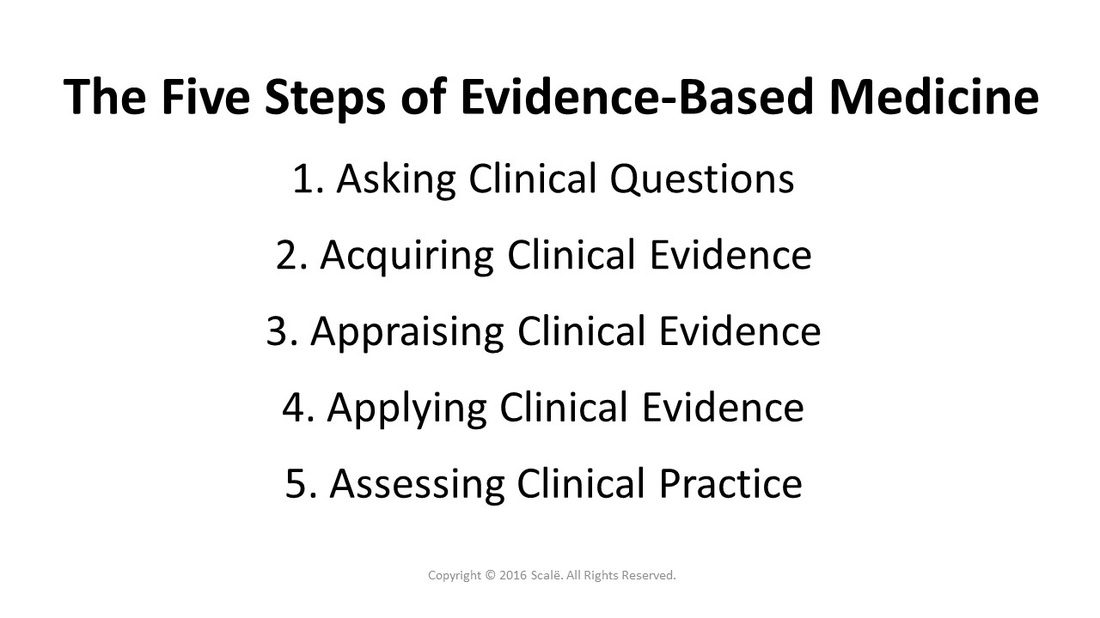Evidence-Based Medicine (EBM)
Evidence-based medicine will play a central role with the advent of the Affordable Care Act
The information on evidence-based medicine presented in the EBM decision tree is based on two seminal texts written primarily by scientists at McMaster University, Ontario, Canada and other prestigious institutions.* All scientific practitioners and academic physicians should have these texts readily available. You, as a potential healthcare recipient, want your physician, surgeon, or therapist to know how to practice evidence-based medicine (EBM). The integration and use of evidence-based medicine principles represents the highest level of ethical, professional, and clinical practice in an ever-changing healthcare marketplace.
The five steps of evidence-based medicine (EBM)
Evidence-based medicine (EBM) is practiced in five sequential steps:
1. Asking answerable clinical questions
2. Acquiring the highest quality evidence available
3. Appraising the clinical relevance and validity of the evidence in the current clinical environment
4. Applying evidence-based interventions in the current clinical environment
5. Assessing the efficacy and utility of EBM practice
1. Asking answerable clinical questions
2. Acquiring the highest quality evidence available
3. Appraising the clinical relevance and validity of the evidence in the current clinical environment
4. Applying evidence-based interventions in the current clinical environment
5. Assessing the efficacy and utility of EBM practice
The three modes of using evidence-based medicine (EBM)
There are three different "modes" of using EBM in any given clinical environment:
1. The "doing" mode where all steps of EBM are completed.
2. The "using" mode where all steps of EBM are applied with the exception of Step 3, where pre-appraised evidence is delivered or sought out.
3. The "replicating" mode where the opinion of leaders and peers in the field are utilized rather than acquiring and appraising evidence (Steps 2 and 3).
1. The "doing" mode where all steps of EBM are completed.
2. The "using" mode where all steps of EBM are applied with the exception of Step 3, where pre-appraised evidence is delivered or sought out.
3. The "replicating" mode where the opinion of leaders and peers in the field are utilized rather than acquiring and appraising evidence (Steps 2 and 3).
Click on the Asking Clinical Questions button to continue.
Hire A Statistician
DO YOU NEED TO HIRE A STATISTICIAN?
Eric Heidel, Ph.D., PStat will provide you with statistical consultation services for your research project at $100/hour. Secure checkout is available with Stripe, Venmo, Zelle, or PayPal.
- Statistical Analysis on any kind of project
- Dissertation and Thesis Projects
- DNP Capstone Projects
- Clinical Trials
- Analysis of Survey Data
*Guyatt G, Rennie D, Meade MO, Cook DJ. Users' guides to the medical literature: A manual for evidence-based clinical practice. Chicago: AMA press; 2008.
*Straus SE, Glasziou P, Richardson WS, Haynes RB. Evidence-based medicine: How to practice and teach it. Edinburgh: Churchill Livingstone; 2011.
*Straus SE, Glasziou P, Richardson WS, Haynes RB. Evidence-based medicine: How to practice and teach it. Edinburgh: Churchill Livingstone; 2011.

